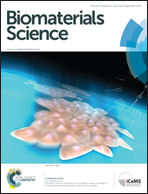Dendrimer mediated clustering of bacteria: improved aggregation and evaluation of bacterial response and viability†
Abstract
Here, we evaluate how cationic gallic acid-triethylene glycol (GATG) dendrimers interact with bacteria and their potential to develop new antimicrobials. We demonstrate that GATG dendrimers functionalised with primary amines in their periphery can induce the formation of clusters in Vibrio harveyi, an opportunistic marine pathogen, in a generation dependent manner. Moreover, these cationic GATG dendrimers demonstrate an improved ability to induce cluster formation when compared to poly(N-[3-(dimethylamino)propyl]methacrylamide) [p(DMAPMAm)], a cationic linear polymer previously shown to cluster bacteria. Viability of the bacteria within the formed clusters and evaluation of quorum sensing controlled phenotypes (i.e. light production in V. harveyi) suggest that GATG dendrimers may be activating microbial responses by maintaining a high concentration of quorum sensing signals inside the clusters while increasing permeability of the microbial outer membranes. Thus, the reported GATG dendrimers constitute a valuable platform for the development of novel antimicrobial materials that can target microbial viability and/or virulence.



 Please wait while we load your content...
Please wait while we load your content...